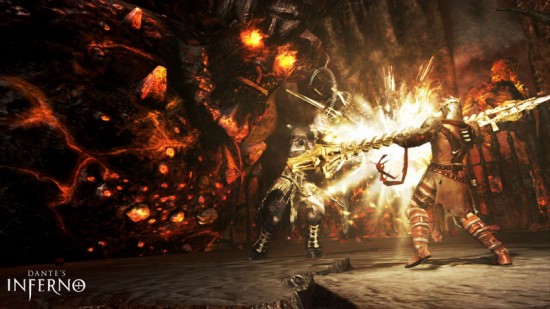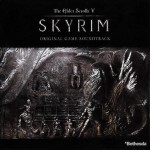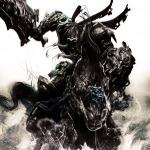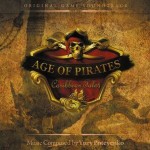In addition to the great poet, Virgil, who is Dante’s guide through his perilous and horrific journey through Hell (and his own redemption), we also have a musical poet to guide us through Visceral Games’ Hell. Much like in 2007’s Bioshock where the underwater city of Rapture became the true antagonist and star of the game, Dante’s Inferno’s Hell is clearly the star here. And, now that I mention it, both games’ scores were composed by same man. Coincidence? Of course not.
It is the great Garry Schyman that tells us with a fervent hand to “Go To Hell.” The only thing left to decide here is whether or not we are happy that he is the one to have sent us there and, more importantly, do we feel like his score has driven us down deep enough into the scourge of all creation to merit the blessing of Dante Alighieri.
Click the jump to find out!
Literary scholars refer to Dante Alighieri as “The Master of the Disgusting.” It is obvious that EA was aware of this when they recreated Dante’s Nine Circles of Hell in video game format. In preparation for this week of Dante’s Inferno, I reread the poem and was stunned at just how graphic, savage, and disgusting Dante’s Hell is. Invariably, I wondered what kind of score could possibly accompany such suffering and horror. Much to my delight (and terror), I was not disappointed.
In short, Garry Schyman’s musical vision of Hell is one of the most awesome and terrifying pieces of music I have ever heard. It is loud, it is relentless, it is complex, and most of it is really ugly. And I could not be more pleased.
The opening track, “Donasdogama Micma,” begins with some ambient sounds that finally swell to the most nefarious of eight-note chorales and, unlike a Bach chorale, this is not pleasing to the ear. It is a huge choir screaming in the Enochian language (not Latin or Italian) being doubled by bombastic brass. This ultimately serves as the main theme of Dante’s Inferno and may take a seat beside some of the greats in how memorable and powerful it is. The harmonies are complex but the emotions that it evokes are quite simple: unsettling horror. Later, “Dante, Casarma Treloch” takes the main theme and injects it with ferocious rhythm and shouting voices (Note: This track is featured in the demo just after Dante returns to find his wife murdered).
The following track, “Storms of Lust,” may be the most accessible and artistic of the lot. It is a haunting theme featuring a solo Soprano voice with some counterpoint among the brass. Unlike some of the later tracks, none of the music here is aleatoric (improvisational “chance” music) and though the rhythm changes jarringly, it does not hit the listener too hard such that he must recalibrate himself.
“Whores of Babylon” begins with brass, percussion, and shrieks of bloody murder. These are women that do not sound like the kind one might find in a library. This, too, has a stalking rhythm about it. In fact, most of the tracks in this soundtrack do not ever allow the listener to predict what will happen next – both harmonically and rhythmically.
A pianist by trade, Garry Schyman proved in Bioshock (as well as in Dante’s Inferno) that he is an incredibly adept string writer. This time, he has shown us a voice-writing prowess that should be the envy of his contemporaries. The track, “Redemption” – a largely unaccompanied chorale of sorts – provides what may be the only truly beautiful music in this collection. In the context of the screams of Hell and the bombastic brass, it provides an emotional respite that is over all too soon, but well worth the experience.
Other highlights include “Tower at the River Styx” which I can see serving as a placeholder on temporary tracks for so many works to come thanks to its menacing rhythm and overall nefariousness.
Dante’s Inferno is not a work that will take up the top spot on your workout playlist. It certainly is not music you would want to hear while studying or trying to relax. But, as a work of drama and a soundtrack, Garry Schyman may have created one of the all-time great video game scores. It is a staggering success because it does not fall into the trappings of atonality to artificially create unsettling feelings. It is constantly driving the player/listener forward and never looking back. With few exceptions, Schyman keeps his pieces tonal as to not detract from the living nightmare in which the player finds himself, but he also steers clear of making a catchy and pretty tune because, after all, this is Hell.
For students of the craft, this soundtrack is a picture-perfect example of how to create a musically complex and difficult score while maintaining an accessibility to anyone daring to journey through Dante’s Hell.
There is a part of me that wishes just a little bit more of this soundtrack could live strongly outside of its immediate context – perhaps even be a bit more melodically pleasing to the ear. But, honoring that request would make Hell just a bit too pleasant. Dante would not have wanted that. By its very definition, Hell must be the most awful place in creation, and Garry Schyman has made sure that we know that.
Stay tuned for more coverage of Dante’s Inferno as we will have an interview with Garry Schyman in the coming days!
Tags: Bioshock, Dante's Inferno, EA, Electronic Arts, Garry Schyman, Hell, Music Reviews, Reviews, Videogame, Visceral Games









































Can’t wait for that Schyman interview! And for Bioshock 2. Any news on that?
Good idea, Sara. Maybe we should talk to him at GDC?